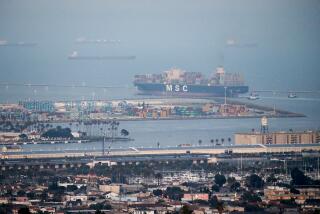West Coast Gets Less Staffing, Customs Officials Acknowledge
U.S. Customs Service officials in Los Angeles acknowledged Thursday that there is a wide disparity between resources devoted between the East and West coasts, leaving the Los Angeles area vulnerable to international crime.
Robert S. Trotter, the assistant commissioner for field operations, said that although customs--and other federal agencies--have historically allotted more resources to the East Coast, the agency had been slow to reassign investigators to new frontiers of criminal activity.
âThe bad guys, theyâre able to shift more quickly than we are,â Trotter said.
Trotter and other top customs officials testified Thursday at a hearing of the House Subcommittee on Government Management, Information and Technology before Rep. Stephen Horn (R-Long Beach), the chairman.
Horn has studied the differences in the staffing the Customs Service assigns to New York, Miami, Los Angeles and other ports of entry, and said Thursday that he planned to pressure the agencyâs leaders to send more personnel to Los Angeles and Long Beach.
âI think there is clearly a disparity,â Horn said.
Faced with a vast area that includes 300 miles of open coastline, the nationâs third-busiest airport and the worldâs third-largest seaport complex, local customs inspectors have a task that âcan best be described as overwhelming,â said John E. Hensley, special agent in charge of the Los Angeles customs office.
Data provided to the committee by the Customs Service show that the agency has placed about twice as many special agents in its New York and Miami offices as it has in Los Angeles, where 167 people are assigned to the investigative unit. Even though it covers the largest metropolitan area of the agencyâs field offices, the Los Angeles unit ranks seventh in size.
But Los Angelesâ seaport receives about three times as many shipping containers as New Yorkâs, and the metropolitan area covered by the Los Angeles customs office has more than triple the population of South Florida.
Horn said he plans to ask the General Accounting Office, the investigative arm of Congress, to present more data on customs deployment of personnel, and he may hold another hearing next spring.
While Trotter acknowledged the disparity in resources, he said the number of investigators at major airports on the East Coast and West Coast are comparable, in part because the agency can use international passenger fees paid at each airport to fund operations. Under current law, it cannot utilize user fees at seaports to pay for more personnel.
Under questioning from Horn, Trotter said the agency could not simply transfer personnel from New York to Los Angeles to bolster its inspection and investigative units. He noted that New York has lost about 1,000 staffers in the last decade because of budget cuts. In recent years, the agency has concentrated new staffing on two areas, South Florida and the San Ysidro border crossing.
*
The nationâs oldest law enforcement agency, the Customs Service was founded in 1789 to levy tariffs and collect revenue for the nationâs treasury. But its role has increased dramatically in recent years. With an annual budget of about $2.1 billion, the Customs Service now shares responsibility for stopping international money-laundering, arms smuggling and Russian organized crime.
To some critics, the agency has expanded into those areas at the expense of its core mission, inspection of cargo and interdiction of drug traffic.
âCustoms headquarters has allocated too great a portion of its resources in pursuit of too many new initiatives,â said Judy Grimsman, president of the Los Angeles Customs Brokers and Freight Forwarders Assn., a trade organization. âIts focus on sexy initiatives should not detract from its key concerns.â
Grimsman said the agency had been slow to automate its processing of cargo, causing unnecessary delays for shippers.
But Horn suggested that the agency is inspecting less cargo than it should, at least in Los Angeles. Earlier this week, he visited the agencyâs centralized examination station in Compton, where inspectors showed off various X-ray devices and a dope-sniffing Labrador retriever named Puckett.
For smugglers, he said, the chance of having contraband discovered by an understaffed agency is âthe cost of doing business.â
More to Read
Sign up for Essential California
The most important California stories and recommendations in your inbox every morning.
You may occasionally receive promotional content from the Los Angeles Times.










